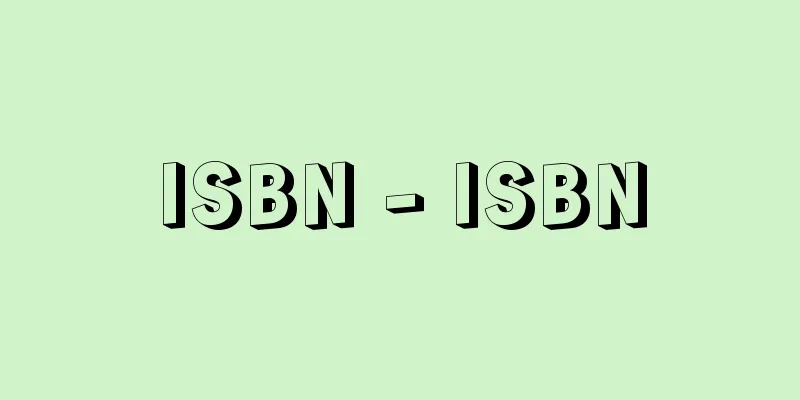ISBN - ISBN

|
Abbreviation for International Standard Book Number. A unique number that is applied to books and materials and has international commonality. It was first adopted by the UK in 1967. In 1971 and 1976, Japan received recommendations for its introduction from the International Standard Numbering Organization in Berlin, and in 1980, the Japan Book Code Management Committee (renamed the Japan Book Code Management Center in 1991) was established and the decision was made to introduce the system. At first, some small and medium-sized publishers opposed the system, saying that it was a "book back numbering system," and it took about 10 years for the adoption rate to reach 99%. The ISBN is made up of a total of 13 digits (digits) including the country code, publisher code, book title code, and check digit. The country code for Japan is 4. In English-speaking countries, it is 0 and 1, in French-speaking countries, it is 2, in German-speaking countries, it is 3, in Russian-speaking countries, it is 5, and in minority language countries, it is 2 or 3 digits. Publishers with a large number of publications have fewer digits in the publisher code and more digits in the book title code. Publishers with lower scores are on the opposite side. In Japan, in addition to the ISBN symbol, the Japan Book Code, which lists classification codes and prices, is also used. In 1986, Seven-Eleven Japan, a convenience store that adopted the POS system in 1982, asked the publishing industry to introduce barcodes, and research began in 1989. In 1992, despite strong concerns from book designers, the ISBN code in OCR-B font and the barcode were used together. In 2002, five publishing-related organizations established the Japan Publishing Organization for Information Infrastructure Development (JPO, originally called Japan Publishing Data Center) with the aim of developing the publishing information system infrastructure and improving publishing distribution. In 2004, the Japan Book Code Management Center was integrated into JPO, becoming a division of JPO. JPO also has a Product Basic Information Center, which develops the publishing information system infrastructure. [Kobayashi Kazuhiro] [Reference] | |Source: Shogakukan Encyclopedia Nipponica About Encyclopedia Nipponica Information | Legend |
|
国際標準図書番号International Standard Book Numberの略称。図書および資料に適用され、国際的共通性をもつ固有の番号。1967年、イギリスが初めて採用した。日本は、1971年(昭和46)ならびに1976年に、ベルリンにある国際標準番号機関から導入の勧告を受けて、1980年、日本図書コード管理委員会(1991年に日本図書コード管理センターと改称)を設置、導入を決めた。当初、中小出版社の一部から「本の背番号制だ」とする反対があり、普及率99%に達するまでに約10年を要した。ISBNは、国別記号、出版者記号、書名記号、チェック数字の合計13桁(けた)の数字で構成する。日本の国別記号は4。英語圏は0と1、フランス語圏は2、ドイツ語圏は3、ロシア語圏は5、少数語圏は2桁か3桁である。出版点数の多い出版者は、出版者記号の桁数が少なく、書名記号の桁数が多い。点数の少ない出版者は逆になる。日本では、ISBN記号のほかに、分類コード、価格などを列記した日本図書コードをあわせて使用する。また、1982年にPOS(ポス)システムを採用したコンビニエンス・ストアのセブン‐イレブン・ジャパンが、1986年に出版業界に対してバーコードの導入を求めたため、1989年(平成1)から研究を開始。ブックデザイナーなどにあった強い懸念を押し切るかたちで、1992年からOCR-Bフォント数字のISBNコードとバーコードを併記するかたちとなっている。2002年には出版関連5団体により、出版情報システム基盤の整備や出版流通の改善等を目的とした一般社団法人日本出版インフラセンター(Japan Publishing Organization for Information Infrastructure Development 略称JPO。設立時の名称は日本出版データセンター)が設立された。2004年に日本図書コード管理センターを統合、JPOの一部門とした。また、JPOには商品基本情報センターがあり、ここで出版情報システムの基盤整備を行っている。 [小林一博] [参照項目] | |出典 小学館 日本大百科全書(ニッポニカ)日本大百科全書(ニッポニカ)について 情報 | 凡例 |
<<: ISP Law - Internet Service Provider (ISP) Law
Recommend
Cavendish Laboratory - Cavendish Laboratory
A physical laboratory belonging to Cambridge Unive...
satura
...However, there were also plays in the Italian ...
Residual sovereignty
When it is recognized that country B's admini...
Heliozoa
…Any of the protozoa belonging to the superclass ...
Vishnevskii, VV (English spelling) VishnevskiiVV
...Also around this time, children's theater ...
Kiusu Ruins - Kiusu Ruins
…Of these, the stone circles and sundials are kno...
Bromeliaceae
…Among monocotyledons, it is related to the Erioc...
Confederation
Union. Alliance. Source: About Shogakukan Digital ...
Fossil Valley
...they are generally filled with thick deposits ...
Undset - Sigrid Undset
A female Norwegian novelist. Born to a famous arc...
Hering-Breuer's reflex
It is also called the pulmonary vagal respiratory ...
Carding
...It also removes impurities. (3) Carding: The f...
United States - United States
[1] [noun] A single state formed by the union of t...
Ursus arctos middendorffi
…Bear [Tadaaki Imaizumi]. . . *Some of the termin...
Sanoze
A city in the Midwest of California, USA. Also kno...








![Ginkonyu [Hot Spring] - Ginkonyu](/upload/images/67d0764f9c770.webp)
